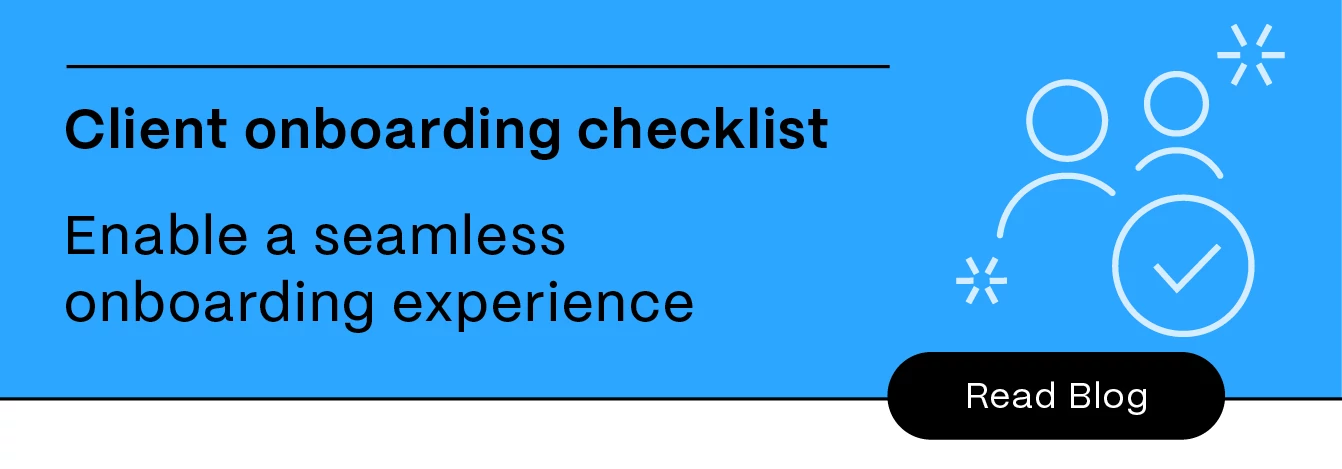
Blog
Healthcare onboarding: best practices and checklist

Onboarding is the cornerstone of a successful healthcare organization. A well-structured onboarding process not only welcomes new employees but also sets the stage for their long-term success and contribution to exceptional patient care.
This guide offers essential best practices and a comprehensive checklist to help you create an exceptional onboarding experience for employees and patients.
What is healthcare onboarding?
Healthcare onboarding is the process of integrating new employees and patients into a healthcare organization or system.
For employees, the onboarding process involves familiarizing them with the company culture, policies, procedures, and roles and responsibilities. Additionally, healthcare onboarding includes specialized training on medical terminology, patient care, regulations, and using EHRs (electronic health records) and other software systems.
For patients, the onboarding process includes the collection of a patient's personal details and medical history. Additionally, patient onboarding involves welcoming them to the healthcare system's procedures, policies, and environment. Depending on the system, it can also involve enrolling new patients into EHRs.
Why is healthcare onboarding important?
The healthcare industry is uniquely characterized by high stakes, complex regulations, and a profound impact on human life. Therefore, a bad onboarding experience can be costly in many ways. Eighty percent of newly hired employees who feel under trained during the onboarding process plan to quit, while 70% of those who feel well-trained plan to stay.

To build a strong foundation for delivering exceptional care, focus on these key areas during onboarding:
- Enhancing employee retention and satisfaction:Healthcare's high turnover rates call for the need to boost job satisfaction and reduce attrition. This can be done by fostering a welcoming culture, providing comprehensive training, and promoting employee wellbeing from the start.
- Improving patient experiences and outcomes: Onboarding equips employees with the knowledge and skills needed to deliver high-quality care. This, in turn, reduces medical errors and enhances patient safety.
- Compliance with healthcare regulations and standards: Healthcare's complex regulatory landscape requires dedicated education to ensure compliance, mitigate risks, and keep up with changing regulations.
Common challenges in healthcare onboarding
Healthcare organizations face unique hurdles when onboarding new employees. These challenges can significantly impact employee retention, patient care, and overall organizational efficiency.
- Regulatory complexity: The healthcare industry is heavily regulated, and compliance requirements can often feel overwhelming. Ensuring new hires understand and adhere to HIPAA (Health Insurance Portability and Accountability Act), OSHA (Occupational Safety and Health Administration), and other regulations can be time-consuming and complex.
- Staff shortages: The healthcare sector is experiencing a persistent staffing crisis. Overburdened HR (human resources) and training departments may struggle to dedicate ample time and resources to onboarding.
- Maintaining strong data security: A lot of critical info that is part of onboarding, sensitive documents in the onboarding process so it’s on the healthcare system to ensure PII is safe and avoids breaches.
- Technology integration: The rapid adoption of EHRs and other healthcare software systems requires robust technology training. However, the complexity of these systems can pose challenges for new employees.
- Clinical skills development: Verifying that new hires possess the necessary clinical skills and competencies can be tedious and resource intensive, particularly in specialized roles.
- Culture integration: Aligning new employees with a healthcare organization's patient-centric culture can be difficult, especially in fast-paced environments.
Overcoming these challenges requires a strategic approach. The next sections explore best practices and comprehensive checklists to help you optimize the healthcare onboarding process and achieve successful employee integration.
Related Read: Stay compliant when sharing HIPAA-regulated content
Healthcare onboarding best practices
Create a smooth transition for new employees, improve patient care, and ensure compliance by following the best practices outlined below:
Prepare before you start
A well-organized onboarding process begins before the employee's first day. Proactive steps include:
- Gather documents: Collect employment contracts, offer letters, and necessary paperwork to streamline the onboarding process.
- Verify credentials: Conduct background checks, license verification, and reference checks to confirm the candidate's qualifications and suitability for the role.
- Prepare the workspace: Set up the employee's workstation with the necessary equipment and supplies, and ensure they have access to relevant systems.
- Develop a comprehensive onboarding plan: Outline the key components of the onboarding process, including training schedules, orientation sessions, and performance expectations.
Offer structured orientation programs
A structured orientation program provides essential information, builds rapport, and instills confidence in the role and company. Key components of an effective program include:
- Organizational overview: Introduce the organization's mission, vision, values, and history.
- Department and role orientation: Explain department goals, structure, and the new employee’s specific role within the team.
- Policy and procedure review: Cover important policies such as attendance, paid time off, and code of conduct.
- Benefits and compensation explanation: Clearly communicate salary, benefits packages, and available resources.
- Safety and compliance training: Address safety protocols, HIPAA, OSHA, and other relevant regulations.
- Technology training: Provide instruction on software and systems, such as EHRs.
- Mentorship or buddy program: Assign a mentor or buddy to offer support and guidance.
- Department tours: Introduce new employees to their workspace and colleagues.
Provide ongoing training and development
Initial onboarding training is essential for new employees to acquire the necessary knowledge and skills. Ongoing professional development is equally important. It ensures employees stay updated with industry advancements, enhance their skills, and maintain a high level of performance.
To support training initiatives, use technology such as e-learning tools to deliver flexible and accessible learning experiences. Online modules, webinars, and virtual simulations can be used to supplement traditional classroom training. Additionally, learning management systems (LMS) can track employee progress and provide analytics to measure training effectiveness.
Facilitate peer mentorship and support
Peer mentorship programs can significantly enhance the onboarding experience for new employees by providing invaluable guidance, support, and a sense of belonging. To create a successful peer mentorship program, implement the following strategies:
- Find potential mentors: Select experienced employees who demonstrate leadership qualities and a commitment to mentoring.
- Provide mentor training: Equip mentors with the necessary skills to adequately support new hires.
- Match mentors and mentees: Consider factors such as shared interests, similar roles, and complementary skill sets when pairing mentors and mentees.
- Establish clear expectations: Define the roles and responsibilities of both mentors and mentees.
- Offer ongoing support: Provide resources and training to mentors throughout the mentorship program.
- Recognize and reward mentors: Acknowledge the contributions of mentors to the organization.
Check-in and solicit feedback regularly
Regular check-ins with new employees are essential for monitoring their progress, addressing any challenges, and gathering valuable feedback. By actively seeking and incorporating employee insights, you can create a more effective and engaging onboarding experience that contributes to long-term employee success and satisfaction. Benefits of regular check-ins include:
- Identifying challenges: Allows new employees to express concerns or difficulties they are facing.
- Measuring progress: Tracks employee development and provides opportunities for coaching and support.
- Building relationships: Fosters open communication and trust between the employee and the organization.
- Improving the onboarding process: Provides valuable insights for refining onboarding strategies.
Healthcare onboarding checklist
Ensure all steps are completed efficiently and consistently by using comprehensive checklists during the onboarding process. This section provides lists for both new hire and patient onboarding processes that your facility can use to improve this experience.
Employee onboarding checklist
Pre-onboarding
- Gather necessary documents (employment contract, offer letter, I-9, W-4, etc.)
- Conduct background checks and verify licenses
- Prepare workspace and equipment
- Assign a mentor or buddy
- Develop a personalized onboarding plan
Day one
- Welcome and orientation
- Introduce key personnel and departments
- Give an organizational overview and mission statement
- Review employee handbook and policies
- Distribute essential paperwork (benefits enrollment, emergency contacts, etc.)
- Provide access to necessary systems and equipment
Week one
- Complete required compliance training (HIPAA, OSHA, etc.)
- Lay out department-specific procedures and protocols
- Detail a shadowing or training schedule
- Host job-specific training
- Outline performance expectations and goals
Month one
- Check in with the new employee to assess progress and address concerns
- Offer ongoing training and development opportunities
- Facilitate team-building activities
- Encourage participation in employee resource groups
- Evaluate onboarding process and gather feedback
Ongoing
- Deliver regular performance feedback and coaching
- Offer career development opportunities
- Conduct stay interviews or surveys to assess employee satisfaction
- Monitor employee engagement and retention
Patient onboarding process checklist
Pre-appointment
- Ensure patient intake forms are available online or in-office
- Share detailed information about the practice and services provided
- Give instructions for insurance verification and co-pay information
- Offer patient portal access and instructions
Day of appointment
- Deliver a welcoming and friendly check-in process
- Facilitate efficient patient registration and data entry
- Convey appointment details, procedures, and expectations
- Make education materials available to patients and their loved ones
- Take questions and concerns from patients and their loved ones
Post-appointment
- Provide clear communication about next steps (follow-up appointments, test results, etc.)
- Supply convenient and secure methods for accessing medical records
- Conduct a patient satisfaction survey
- Simplify the referral process for specialists or additional services
- Implement a reminder system for follow-up appointments and preventive care
Related Read: Client onboarding checklist: your comprehensive guide

Overcome healthcare onboarding challenges with technology
Effective onboarding is essential for employees in the healthcare industry. However, factors like the complex regulatory environment and staff shortages present significant challenges.
Technology is key to overcoming these hurdles. From pre-onboarding steps like gathering documents and verifying credentials to ongoing training and development, technology can streamline and enhance every stage of the process. It offers invaluable tools for managing patient information, delivering training, and tracking employee progress.
By implementing the strategies and checklists outlined in this article and embracing technology, you can optimize your healthcare onboarding processes and achieve better outcomes.
Related Resources
